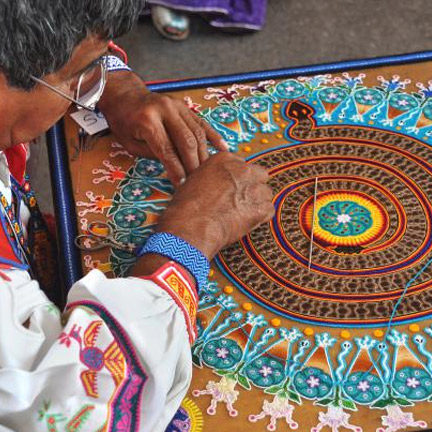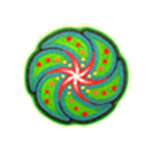Traditional Huichol Art

Traditional - Huichol art
The elders, who long, long time in the Huichol sierra grandparents met to discuss the situation in which they found themselves. His people were sick, no food, no water, the rains came and the land was dry.
During the 1890’s and 1898, a Norwegian ethnographer and explorer, Carl Lumholtz studied Huichol art intensely during a five year stint in northwestern Mexico. Aside from the fact that he discovered that all Huichol art had symbolic and religious meanings, commonly found motifs were animals and plant motifs. The prominent motif, a small, five-petalled flower called a toto, is an actual flower that grows in those parts during the rain seasons. This design and pattern is embroidered according to individual artist’s tastes. The art found in belts and sashes imitated the markings you find on a real snake’s back, something which the people associated with long life, health, good crops and rain. When you find a scorpion pattern on a belt or sash it was and still is indicative as charm against venomous creature attack. This is where gourd bowls was first seen and discovered as used by the Shamans. They filled these bucket like bowls with images of family members, animals, corn etc. it is very colorfully decorated and always carried during prayers for protection, ceremonies and placed in sacred sites and shrines throughout Huichol homelands. The significance of colors also came to light and runs the same way until today’s current Huichol art. Orange symbolizes Wirikuta, which is their sacred land where all life began according to the Huichol and this is also where they pilgrim to find peyote. Yellow is used during ceremonies for face painting and comes from a root that grows in Wirikuta. Green symbolizes growth, grandfathers, the heart, healing, the heavens, and the earth. Blue signifies femininity, rain, water, Pacific Ocean and the South. Red signifies masculinity, fire and the East while white signifies the cloud spirits. Traditional Huichol art opens a wide window on the spiritual past, supernatural realms and spirits that are much more than superstition but a true believe that the world has more than only one “reality”.
They began distributing peyote (híkuri) to everyone after a while he healed, fed and removed their thirst.
Since then the Huichols venerate the same time that peyote is deer and maize, its guiding spirit. So each year until our times, keep walking and sojourning, keeping alive the route of the Huichol mountains to Wirikuta, to ask God for rain, livelihood and health for their people.
Pampariusi (thanks in Wirrarika language).

